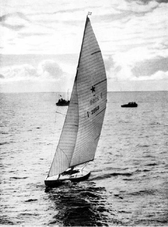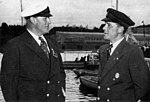Sailing at the 1952 Summer Olympics
In this article, we will explore the exciting world of Sailing at the 1952 Summer Olympics and all the facets that involve it. From its origins to its impact on today's society, Sailing at the 1952 Summer Olympics is a topic that deserves detailed and thoughtful attention. Along these lines, we will analyze its relevance in different contexts, as well as the controversies and debates that surround it. With a critical and objective approach, we will delve into Sailing at the 1952 Summer Olympics to understand its importance and challenges today. This article will undoubtedly provide a comprehensive overview of Sailing at the 1952 Summer Olympics and leave the reader with a greater understanding and appreciation for this topic.
| Sailing at the Games of the XV Olympiad | |
|---|---|
 Official pin of the 1952 Summer Olympics | |
| Venues | Harmaja |
| Dates | First race: 20 July 1952 Last race: 28 July 1952 |
| Competitors | 227 from 29 nations |
| Boats | 93 |
Sailing/Yachting is an Olympic sport starting from the Games of the 1st Olympiad (1896 Olympics in Athens, Greece). With the exception of 1904 and the canceled 1916 Summer Olympics, sailing has always been included on the Olympic schedule. The Sailing program of the 1952 Summer Olympics consisted of a total of five sailing classes (disciplines). For each class seven races were scheduled from 20 to 28 July 1952 of the coast of Harmaja.
The sailing was done on the triangular type Olympic courses. The start was made in the center of a set of 8 numbered marks that were places in a circle. During the starting procedure the sequence of the marks was communicated to the sailors. By picking the mark that was most upwind the start could always be made upwind. This system is, at least in certain German lakes, still in use.
Venue
Island Lighthouse Harmaja | |
|---|---|
 | |
| Coordinates: 60°6′16.88″N 24°58′26.93″E / 60.1046889°N 24.9741472°E |
Liuskasaari Olympic Harbor | |
|---|---|
| Coordinates: 60°9′6″N 24°56′52″E / 60.15167°N 24.94778°E |
Two course areas were created in front of Helsinki. One for the Finn just outside the island Liuskasaari. The Finn course was 5.4 nm long and triangular in shape. For the keelboats a course area near the Harmaja lighthouse was used. A 13.1 nm course was set for Star, Dragon, 5.5 & 6 Metre just over one nm South of the lighthouse. Specially the keelboat course was situated in an area of fair sailing conditions. No currents or tidal movements, and no obstacles around the course that could create wind shadows. On the other hand, the Finn course was set near sheltered islands and thus safe for this type of sailing. This course give the spectators also a nice view of the races.
The races were held from 20 to 23 and 26–28 July. In between the sailors could recover or made boat repairs.
Three yacht clubs were involved:
- Nyländska Jaktklubben
- Helsingfors Segelsällskap
- Merenkävijät Yachting Club (also for the prize giving ceremony)
Competition
Overview
| Continents | Countries | Classes | Boats | Male | Female |
|---|---|---|---|---|---|
| 5 | 29 | 5 | 93 | 227 | 3 |
Continents
Countries
Classes (equipment)
The 1952 Olympic classes | |||||||||
| Class | Type | Event | Sailors | Trapeze | Mainsail | Jib/Genoa | Spinnaker | First OG | Olympics so far |
|---|---|---|---|---|---|---|---|---|---|
| Finn | Dinghy | 1 | 0 | + | – | – | 1952 | 1 | |
| Star | Keelboat | 2 | 0 | + | + | – | 1932 | 4 | |
| Dragon | Keelboat | 3 | 0 | + | + | + | 1948 | 2 | |
| 5.5 Metre | Keelboat | 3 | 0 | + | + | + | 1952 | 1 | |
| 6 Metre | Keelboat | 5 | 0 | + | + | + | 1908 | 9 | |
| Legend: | |||||||||
Medal summary
| Event | Gold | Silver | Bronze |
|---|---|---|---|
1952: Finn |
Paul Elvstrøm |
Charles Currey |
Rickard Sarby |
1952: Star |
Agostino Straulino Nicolò Rode |
John Price John Reid |
Joaquim Fiúza Francisco de Andrade |
1952: Dragon |
Thor Thorvaldsen Haakon Barfod Sigve Lie |
Per Gedda Erland Almqvist Sidney Boldt-Christmas |
Theodor Thomsen Erich Natusch Georg Nowka |
1952: 5.5 Metre |
Britton Chance Michael Schoettle Edgar White Sumner White |
Peder Lunde Vibeke Lunde Børre Falkum-Hansen |
Folke Wassén Carl-Erik Ohlson Magnus Wassén |
1952: 6 Metre |
Herman Whiton Everard Endt John Morgan Eric Ridder Julian Roosevelt Emelyn Whiton |
Finn Ferner Tor Arneberg Johan Ferner Erik Heiberg Carl Mortensen |
Ernst Westerlund Ragnar Jansson Jonas Konto Rolf Turkka Paul Sjöberg |
Medal table
| Rank | Nation | Gold | Silver | Bronze | Total |
|---|---|---|---|---|---|
| 1 | 2 | 1 | 0 | 3 | |
| 2 | 1 | 2 | 0 | 3 | |
| 3 | 1 | 0 | 0 | 1 | |
| 1 | 0 | 0 | 1 | ||
| 5 | 0 | 1 | 2 | 3 | |
| 6 | 0 | 1 | 0 | 1 | |
| 7 | 0 | 0 | 1 | 1 | |
| 0 | 0 | 1 | 1 | ||
| 0 | 0 | 1 | 1 | ||
| Totals (9 entries) | 5 | 5 | 5 | 15 | |
Remarks

- Sailors from abroad were housed in the homes of Finnish yachtsmen
- Two motor launches accommodated pressmen on the yacht race courses
- Only the Yachting officials wore a different official uniform, blue coat and grey trousers
- The Danish shipyard of Borresens Baadebygger was the builder of all Finn dinghies, since then till the beginning of the 21st century closely committed to Olympic Sailing.
Sailors
During the sailing regattas at the 1952 Summer Olympics among others the following persons were competing in the various classes:
 Denmark (DEN), Paul Elvstrøm in the Finn won his second consecutive Gold medal
Denmark (DEN), Paul Elvstrøm in the Finn won his second consecutive Gold medal Sweden (SWE), Finn sailor Rickard Sarby, also designer of the Finn, injured his right hand during however he took the third place
Sweden (SWE), Finn sailor Rickard Sarby, also designer of the Finn, injured his right hand during however he took the third place Australia (AUS), Jock Sturrock in the Dragon. Later skipper of "Gretel" and "Dame Pattie", the first two Australian challenges for the America's Cup.
Australia (AUS), Jock Sturrock in the Dragon. Later skipper of "Gretel" and "Dame Pattie", the first two Australian challenges for the America's Cup.
Notes
- ^ "Sailing at the 1952 Summer Olympics". Olympedia. Retrieved 31 May 2020.
References
- Organizing Committee of the XV Olympiad Helsinki 1952 (1955). The Officiel Report of the Organizing Committee for the games of the XV Olympiad Helsinki 1952 (pdf).
{{cite book}}: CS1 maint: numeric names: authors list (link) - Hugh Drake & Paul Henderson (2009). Canada's Olympic Sailing Legacy, Paris 1924 – Beijing 2008. Toronto: CYA. ISBN 978-0-9595468-0-4.
- "Helsinki 1952". Olympics.com. International Olympic Committee.






